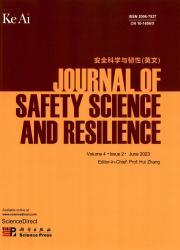Dynamic risk assessment of gas pipeline operation process by fusing visual and olfactory monitoring
Abstract
With the rapid increase in urban gas consumption, the frequency of maintenance and repair of gas pipelines has escalated, leading to a rise in safety accidents during these processes. The traditional manual supervision model presents challenges such as inaccurate monitoring results, incomplete risk factor analysis, and a lack of quantitative risk assessment. This research focuses on developing a dynamic risk assessment technology for gas emergency repair operations by integrating the monitoring outcomes of artificial olfactory for gas leakage information and video object recognition for visual safety factor monitoring data. To quantitatively evaluate the risk of the operation process, a three-dimensional risk assessment model combining gas leakage with risk-correlated sensitivity was established as well as a separate three-dimensional risk assessment model integrating visual risk factors with predictable risk disposition. Furthermore, a visual risk quantification expression mode based on the risk matrix-radar map method was introduced. Additionally, a risk quantification model based on the fusion of visual and olfactory results was formulated. The verification results of simulation scenarios based on field data indicate that the visual-olfactory fusion risk assessment method can more accurately reflect the dynamic risk level of the operation process compared to simple visual safety factor monitoring. The outcomes of this research can contribute to the identification of safety status and early warning of risks related to personnel, equipment, and environmental factors in emergency repair operations. Moreover, these results can be extended to other operational scenarios, such as oil and gas production stations and long-distance pipeline operations.

 求助内容:
求助内容: 应助结果提醒方式:
应助结果提醒方式:


